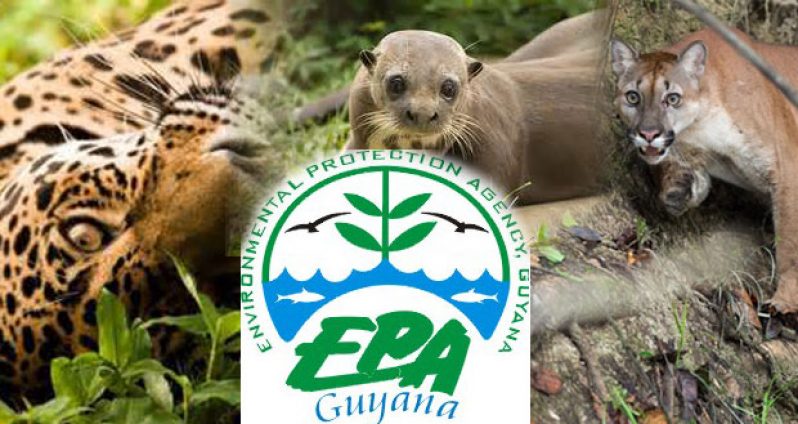Guyana has one of the largest unspoiled rainforests in South America, some parts of which are almost inaccessible by humans.
Over 80% of Guyana is still covered by forests, ranging from dry evergreen and seasonal forests to lowland evergreen rain forests. Six of the 36 wildcat species that exist in the world roam the largely pristine forest and natural corridors that exist in Guyana.
These are:
• Jaguarondi (Puma yagouaroundi) also known as the Eyra or Otter cat.
The body of jaguarondi is covered with uniformly coloured fur. Depending on the habitat, colour of the fur can be reddish, grayish or black to brownish. Unlike many other South American cats, jaguarondi spends majority of time on the ground, usually in dense vegetation or heavy bushes. They are very vocal animals producing 13 different sounds for communication and can jump 6.5 feet in the air to catch a flying bird. Jaguarondi is a mainly diurnal (active during the day) animal.
• Margay (Lepardus wiedii), also known as the Tree Ocelot, Climbing Ocelot, Little Ocelot or Tigrillo.
Margay’s fur can be grayish to cinnamon in colour. It is covered with black-ringed rosettes. They have large eyes adapted to night vision since they are nocturnal (active at night). They can survive less than 10 years in the wild and up to 20 years in captivity. Unlike other cats, margay is able to move down the tree, with its head going before its feet. This is possible because it has flexible ankles of the front feet that can be rotated for 180 degrees.
• Oncilla (Lepardus tigrinus), also known as the Little Spotted Cat, Tigrillo, Tiger Cat or Little Tiger Cat
The body of an oncilla is covered with beautiful fur that can be tan or ochre in colour. Upper side of the body is covered with dark rosettes while the lower side is pale and contains a few spots. Its tail is covered with black rings and ends with black tip. One fifth of all oncillas are completely black. Young animals produce a unique purring sound, while adult animals produce a gurgling sound when they meet each other. Oncilla is active at twilight (crepuscular animal) and night (nocturnal animal).
• Jaguar (Panthera onca), also known as the Tiger, Pouss, Turtle Tiger
Jaguars are the largest of South America’s big cats. Most jaguars are tan or orange with distinctive black spots, dubbed “rosettes” because they are shaped like roses. Some jaguars are so dark they appear to be spotless, though their markings can be seen on closer inspection.
• Puma (Puma concolor) also known as the Cougar, Panther, Mountain Lion, Red Tiger, or Deer Tiger
The Puma is the fifth heaviest of wildcats after the lion, leopard, jaguar and tiger. They have a plain coloured fur ranging from tawny to silver grey or reddish brown with lighter patches on their underparts including the jaws, chin and throat. The name of a male is referred to simply as a ‘Puma’, while the female is referred to as a ‘she-Puma’ and the young are called ‘cubs’.
• Ocelot (Leopardus pardalis) also known as the Tigrillo, Painted Leopard, Hagtiger, or Dwarf Leopard.
The Ocelot is much larger than its cousins the Margay and the Oncilla, although they bear a striking resemblance. Twice the size of the average house cat, the ocelot is a sleek animal with a gorgeous dappled coat. These largely nocturnal cats use keen sight and hearing to hunt rabbits, rodents, iguanas, fish, and frogs. They also take to the trees and stalk monkeys or birds.
It is important to note that all wild cats in Guyana are protected in accordance with the Third Schedule of the Wildlife Management and Conservation Regulations (WMCR) 2013. Therefore, trapping, killing or injuring of these animals is a crime that is punishable by law.
In some instances, humans and these wildcats will interact. However, we urge you to be cautious and thoughtful in your action when dealing with these animals. If you do encounter these animals, the first move should not be to kill or injure. Make a report to the nearest police station or to the EPA so that a proper solution can be found as long as it does not pose an immediate threat.
SOURCES:
http://www.softschools.com/
http://animals.nationalgeographic.com/
For more information on the Wildlife Management and Conservation Regulations (WMCR) 2013 or to make a complaint against any person or group causing or contributing to the harm of wildlife; you can call 225-6044/225-5471/225-5467 ext 226 or email to epa@epaguyana.org or eit.epaguyana@gmail.com.



.jpg)








